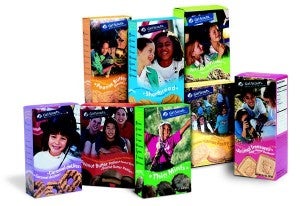Fans of Dulce de Leche and “Thank U Berry Munch” Girl Scout cookies, we have some bad news for you.
When Girl Scouts hit the streets (and Mom’s or Dad’s office) with order forms over the next few weeks to sell the organization’s iconic treats, many will do so with a scaled-back selection that omits newer varieties added in recent years in favor of focusing on the tried-and-true brands, including Thin Mints, Samoas (also called Caramel deLites) and Tagalongs (aka Peanut Butter Patties).
According to a story in The Wall Street Journal, Girl Scouts of the USA decided to test a more limited cookie menu in a dozen regions this year in an effort to cut costs, increase profits and retain customer interest in tight economic times when $4 sounds like a lot for a box of cookies. Cookie sales bring in more than $700 million each year for the Girl Scouts, or up to two-thirds of many of the 112 councils’ annual budgets, the Journal reported.
The reasoning behind the strategy is evident in a breakdown of cookie sales: Varieties like Thank U Berry Munch (a cookie with cranberries and white fudge chips) and Dulce de Leche (flavored with milk and caramel chips) have failed to gain much of a following. Neither did sugar- or trans-fat-free flavors designed to attract the health conscious.
Figures from the Girl Scouts show that Thin Mints account for a quarter of all sales, followed by Samoas at 19%, Tagalongs at 13%, Peanut Butter Sandwich cookies (aka Do-si-dos) at 11% and Shortbread Trefoils at 9%. The other flavors combined for the remaining 23%.
The new strategy — which also includes seminars and “cookie colleges” to teach girls business skills — makes sense to Wharton marketing professor Patricia Williams, who notes the efficiencies that come from fewer varieties to produce and easier inventory to manage.
She also points to research suggesting that there is such a thing as too many choices. “Consumers are attracted by a wide variety, but are less likely to buy from a big choice set and less likely to be satisfied with their choice when they get it home.” On the other hand, when consumers pick from a smaller number of options, “they know what they like best…. The question for the Girl Scouts will be, ‘What is the right amount of choice?'”
Williams and Barbara Kahn, a Wharton marketing professor and director of the Jay H. Baker Retailing Center, also have some ideas about why consumers didn’t flock toward healthier varieties of Girl Scout cookies. According to the online health website Calorie Count, two Tagalongs have 150 calories and eight grams of fat — enough to earn them a D-plus grade for nutrition. But as Kahn notes, “There’s something magical about Girl Scout cookies,” because they’re only available once a year and, in many families, selling the treats is a tradition handed down through generations. “It’s kind of like when you’re on vacation, food shouldn’t have calories. When it’s a Girl Scout cookie, that’s not the time you want to be reminded about low fat.”
Williams and a doctoral student did some research for the student’s dissertation that showed “when consumers want to indulge, they want to indulge.” They are uninterested in cookies minus the fat — or in Coke or ice cream infused with vitamins. “You meet the lower fat or lower sugar goals by not eating cookies. But it’s the sinful aspect of the cookie that makes it a cookie.”



